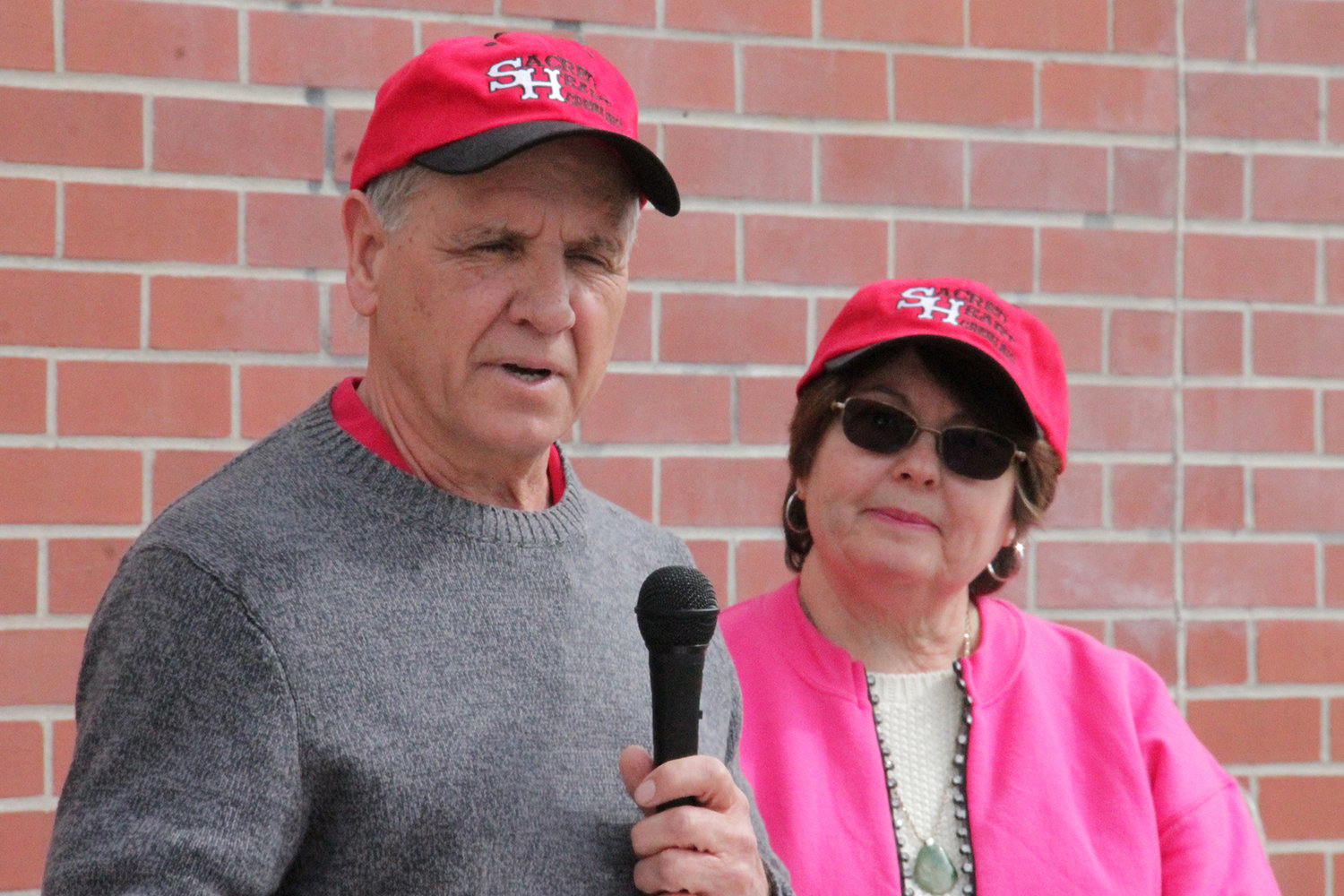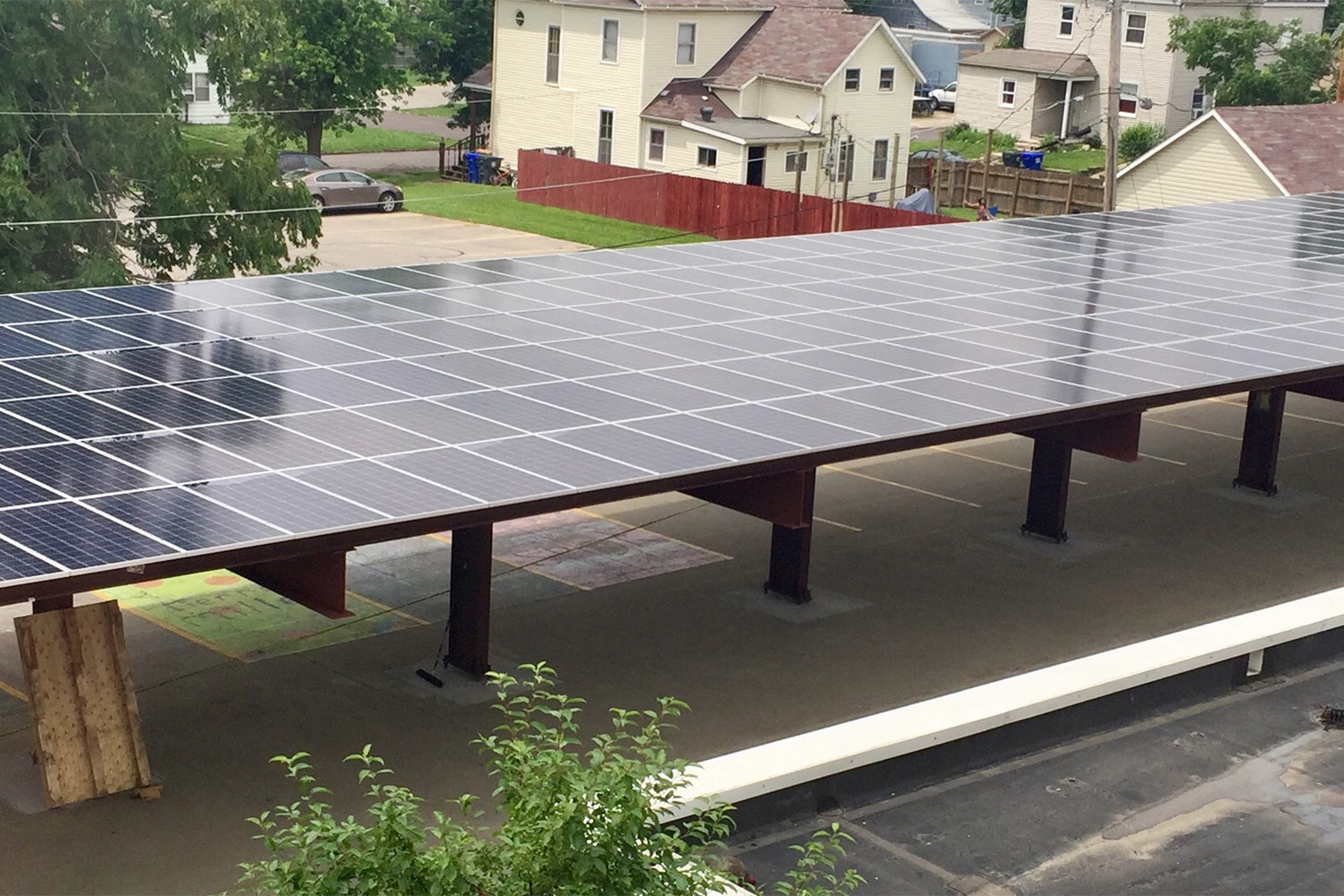Couple’s gift sparks savings, learning opportunities in Sedalia

A Sedalia couple believes their investment in Catholic education will still be paying dividends long after the kindergarteners at Sacred Heart School (SHS) have children of their own.
Sacred Heart parishioners Steve and Karen Ellebracht donated the seed money to build a steel platform on school property and adorn it with an array of solar panels.
Beginning this school year, students will be able to monitor and learn about how the panels capture energy from the sun and convert it to electricity that the school can either use or sell back to the local power utility.
In the process, the school stands to save up to $15,000 a year on its utility costs.
“We wanted to give something to the school that would continue to give, and a solar array will certainly do that,” said Mr. Ellebracht. “We also wanted something that would enhance the educational experience of the students and the value and the aesthetics of the campus, and we think this will.”
The platform for the solar array serves as a canopy over part of one of the school’s parking lots, providing welcome shade while maximizing exposure to the sun.
The solar panels and related equipment carry a 30-year warranty and are expected to last much longer, with energy savings projected to go up with the price of electricity.
The total cost of the project, estimated at $330,000, is covered entirely by grants and the Ellebrachts’ donation to the Sacred Heart School Foundation.
In addition, architects, engineers and business leaders from the school community volunteered their time for advice and consulting.
Subcontractors included Missouri Solar Applications for the solar array, Medallion Electric for the electrical interconnections, Jackson Concrete Design for the footings, and Arning Companies for the steel canopy structure.
“The fact that a project of this magnitude can become reality completely through grants and private donations is awe inspiring,” said Dr. Mark Register, Sacred Heart School administrator.
“Sacred Heart works because so many people continue to come together as a community to make it so,” he added.
Harvesting a sliver
The solar array has been set up on a net meter basis with Kansas City Power and Light (KCP&L), which provides electric service in Sedalia.
When the array produces more than the school is using on that meter, the energy flows back into the KCP&L power grid, which the school then receives credit for.
Energy calculations indicate the solar array will cover the cost of nearly one-fourth of the power consumed by the school.
Inverters will record and monitor the power produced. Information from the inverters will be posted on the Internet for access and review.
Mr. Ellebracht worked for Dow Chemical Co. for 34 years, retiring 10 years ago as the senior global research and development director.
He noted that the sun is over a million times larger than the earth.
“Even though the earth only gets a small sliver of the sun’s energy, enough solar energy reaches the earth in one hour to power all of mankind’s needs for a year,” he said.
The key is to learn how to capture and distribute that energy in order for it to contribute substantially to meeting humanity’s needs, he said.
Precious Blood Father Mark Miller, recently retired pastor of Sacred Heart and St. Patrick parishes in Sedalia and St. John the Evangelist mission in Bahner, said the project amounts to good stewardship of not only money but also the environment.
He pointed to Church teaching on care for God’s creation, as articulated in Pope Francis’s encyclical, “Laudato Sí.”
“As St. Francis of Assisi understood, all of life is our brother or sister,” Fr. Miller noted. “May we continue to make connections between the natural creation and our own creative imagination as we move forward in bringing about the Kingdom of God.”
“Ready to learn”
Mrs. Ellebracht grew up in a traditionally Italian neighborhood known as The Hill in St. Louis, while Mr. Ellebracht grew up on a farm in Cooper County.
She went to St. Ambrose School on The Hill, he went to the old St. John the Baptist School in Clear Creek.
“We had three Benedictine sisters in two rooms at St. John the Baptist School,” Mr. Ellebracht recalled.
Because he was one of 12 siblings, there were usually three or four from his family in the same classroom.
“You gotta’ respect the nuns!” he said. “They taught us everything we needed to know.”
The couple settled on Sedalia after retirement.
They quickly got active in the parish and community.
“We wanted to get involved with education,” said Mr. Ellebracht. “Karen and I have five children, and education was a key part of wherever we lived, and we’ve lived in a number of places around the world. One of the real gems we found in Sedalia is Sacred Heart School.”
Mrs. Ellebracht began volunteering as the school librarian. Mr. Ellebracht serves on the SHS Foundation board and occasionally helps teach high school chemistry.
“I like relating what they are learning to solving real life problems,” he said.
They were immediately impressed with the upbeat, friendly, caring culture at Sacred Heart School.
“The students are respectful, helpful and ready to learn,” said Mr. Ellebracht. “The teachers and staff are great.”
Grateful for all God has done for them, they wanted to give something back.
After months of research with parish and school officials, they settled on the solar array.
He noted that the solar array offers the students many opportunities for hands-on technical calculations and learning.
“Look around”
After pitching the idea to SHS Foundation President Beverly Rollings, the couple worked out the specifics with the foundation, the parish council and school board, the diocesan Office of Buildings and Properties, KCP&L, the city staff and several government agencies.
The work, which received approval from Bishop W. Shawn McKnight, is in keeping with the U.S. Conference of Catholic Bishops’ Environmental Justice Program.
A ground-breaking ceremony took place on April 5.
“May this structure be a constant reminder of how we are to be good stewards of all of God’s resources so as to benefit the common good,” Fr. Miller prayed.
Construction continued through the summer.
The array began generating electricity at 11 a.m. on June 26.
As of Aug. 6, the energy savings produced thus far had exceeded $2,000.
Mrs. Ellebracht emphasized that the couple’s gift is part of something substantially larger.
“We’re just adding on to what so many people have been doing here,” she said. “Look around at what people have already done, what’s already been built! All we’re doing is adding to it.”
Comments
Other items that may interest you
Services
The Catholic
Missourian
2207 W. Main St.
Jefferson City MO 65109-0914
(573) 635-9127
editor@diojeffcity.org







